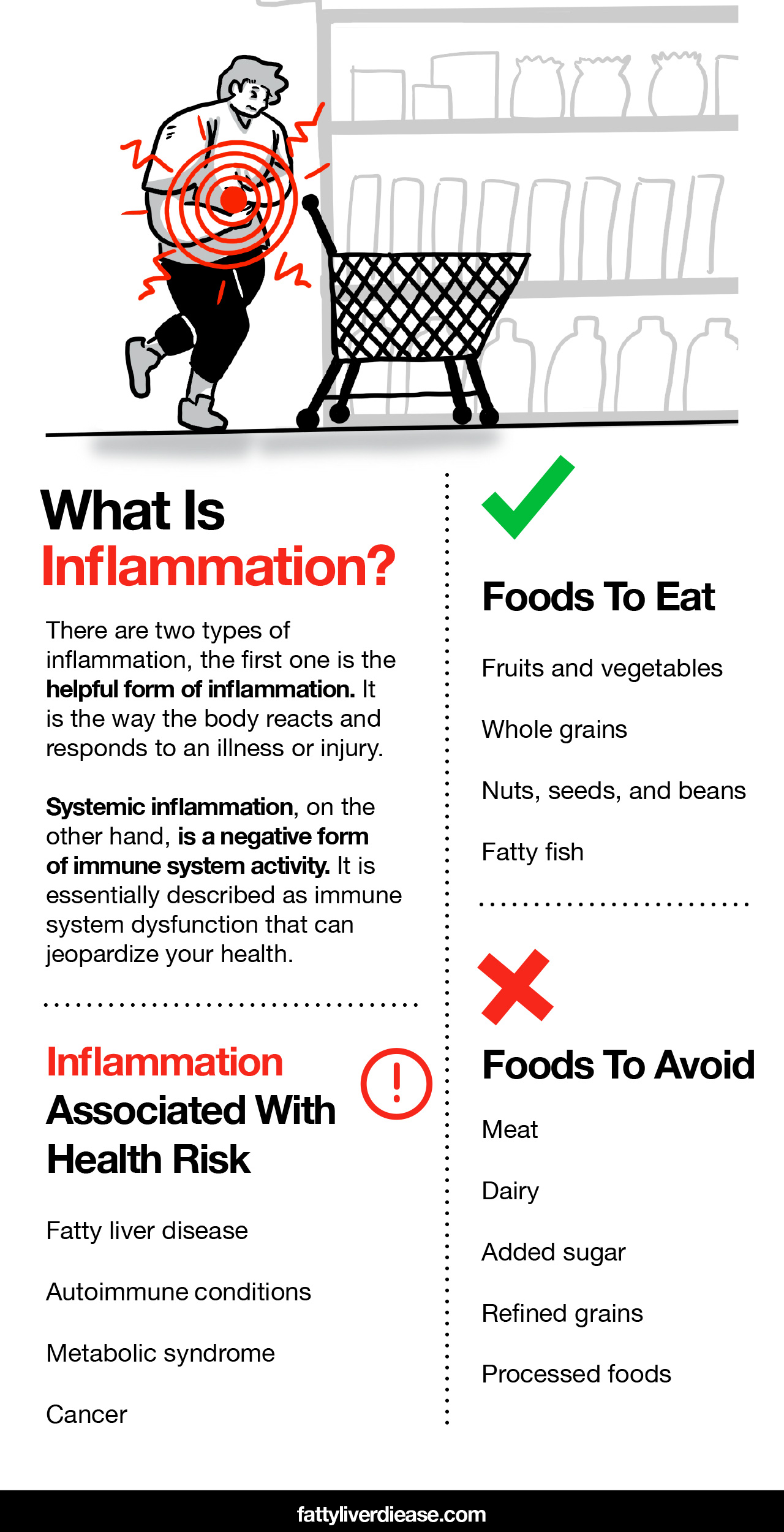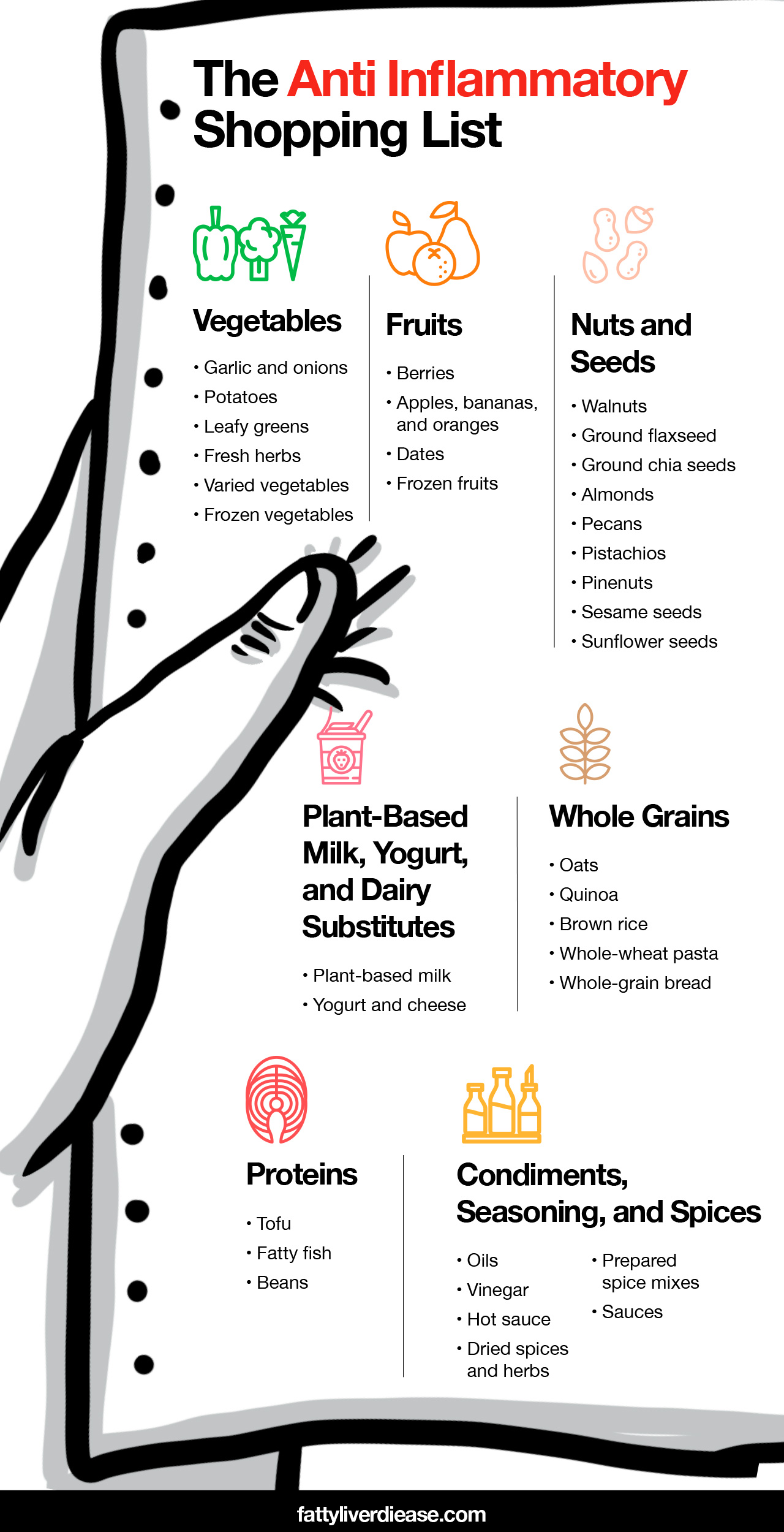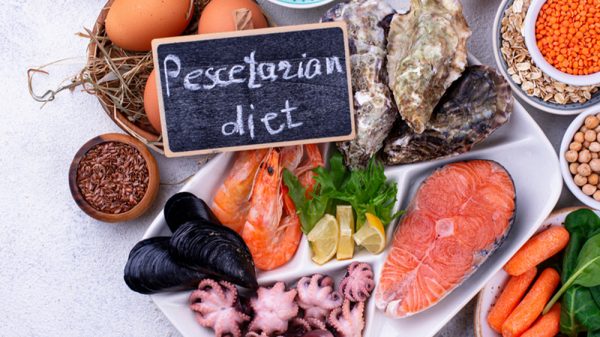Inflammation is a buzzword these days that is often associated with many different diseases and health conditions. What exactly is inflammation and how does it affect your health? Inflammation is a maladaptive state of the immune system that can over time compromise the health of other organ systems, such as the liver and brain.
Thankfully, inflammation can be largely taken care of and prevented by eating the right foods. In this article, we go over everything you need to know about inflammation, and we include helpful information about how to follow an anti-inflammatory diet, including an anti-inflammatory meal plan and shopping list.
What Is Inflammation?
Before we go any further, let’s drill into what it means to experience inflammation.
Many people don’t realize that there are actually two types of inflammation. The type of inflammation that we typically hear about has a very negative connotation, and rightfully so since it is a major cause of so many diseases and conditions.
There is, however, an adaptive form of inflammation. The helpful form of inflammation is the way the body reacts and responds to an illness or injury. When the body sustains a physical injury or is infected by viruses or bacteria, the immune system responds by launching an attack. This attack is referred to as inflammation because the immune system revs up and prepares to either repair damaged tissues or fight off the Invaders pathogens. As soon as the physical injury heals or the infection is cleared, the immune system calms down from its aggravated state. Without this form of inflammation, the body’s immune system would not be able to effectively and efficiently repair wounds and fight off invaders that cause infection.
Systemic inflammation, on the other hand, is a negative form of immune system activity. Systemic inflammation is a state of chronic immune system activation in the absence of a physical injury or an infection. In these conditions, the immune system remains activated and is hypersensitive. The immune system continues to release inflammatory cytokines that interfere with the body’s normal functions on a cellular level. Systemic inflammation essentially describes immune system dysfunction that can jeopardize your health.
What Causes Systemic Inflammation?
Though not all causes of systemic inflammation have been identified, there are a couple of very clear causes. There is a genetic component, meaning that you may be more prone to inflammation and related conditions if you have family members with inflammatory health conditions.
Environmental factors also play a significant role in determining whether someone will experience inflammation. Diet and stress are the two major components of environmental exposure that can influence your levels of inflammation.
Mechanism of Inflammation
Inflammation is connected to another buzzword in the health world: oxidative stress. Inflammation and oxidative stress are inextricably connected. But what exactly is oxidative stress, and how is it linked to inflammation?
Oxidative stress essentially describes a mechanism through which environmental exposure to an unhealthy diet, stress, and chemicals can trigger inflammation. When you eat unhealthy foods, experience chronic stress, or are exposed to hazardous chemicals, the mitochondria in cells throughout the body begin to produce a greater number of reactive oxygen species than the body can handle. Reactive oxygen species are also referred to as free radicals, and having too many of them ultimately causes damage to cellular bodies and tissue. This chronic state of oxidative stress and damage will then cause systemic inflammation. (1)
Inflammation is Associated with Health Risks
Chronic inflammation is a serious causal factor at the root of so many health conditions. Let’s take a look at a few of the conditions that are associated with inflammation:
- Fatty liver disease: Inflammation is a major culprit when it comes to the development and progression of both alcoholic and nonalcoholic fatty liver disease. Fatty liver disease describes the accumulation of fat in the liver, which can result in inflammation and compromised liver function, causing the condition to potentially progress to steatohepatitis, fibrosis, and cirrhosis.
- Autoimmune conditions: Autoimmune diseases are a direct result of a dysfunctional immune system. Autoimmune disease, such as multiple sclerosis and lupus, occur when the immune system attacks the body’s own tissues, instead of foreign invaders. These diseases can have devastating consequences that affect quality of life and independence.
- Metabolic syndrome: Inflammation plays a significant role in the development of metabolic syndrome. In particular, a poor diet that causes inflammation results in insulin dysfunction, weight gain, and type 2 diabetes.
- Cancer: Inflammation even plays a role in the development of cancer! Under normal circumstances, the body often makes mistakes in the process of cell division, creating imperfect cells with damaged DNA. Sensing the damage, the immune system signals the cell to undergo apoptosis and eliminates the cell as waste. This process greatly reduces that risk of damaged cells reproducing to cause cancerous growths called tumors. When the immune system function is compromised, it is unable to effectively detect and get rid of potentially cancerous cells that contain damaged DNA. This increases the likelihood that damaged cells will proliferate and cause cancer.
The Anti Inflammatory Meal Plan and Shopping List
Following an anti-inflammatory meal plan is a key component to lowering your levels of systemic inflammation, and therefore decreasing your risk of developing so many health conditions. An anti-inflammatory diet can even help facilitate weight loss while also lowering the risk of fatty liver disease, type 2 diabetes, and cardiovascular disease. Here we give you a complete guide to cleansing your diet of inflammatory foods while incorporating foods that help mitigate inflammation and oxidative stress.
Before we dive into recipe ideas for the anti-inflammatory meal plan and shopping list, let’s first look at foods that you should eat and foods that you should avoid.
Foods to Eat on the Anti Inflammatory Diet
An anti-inflammatory diet should be rich in whole foods, including fruits, vegetables, and whole grains.
- Fruits and vegetables: Why are fruits and veggies such an important part of the anti-inflammatory diet? Produce is packed with healing antioxidants, vitamins, and minerals that fight against oxidative stress. Antioxidants are particles that directly neutralize free radicals, preventing them from inflicting damage and making it easy to remove the damaging particles from the body. Eating a colorful array of fruits and veggies is key to ensuring hta you get a wide array of healing antioxidants. These tiny compounds are usually categorized as either polyphenols or carotenoids. Certain vitamins like vitamins C and E also exhibit antioxidant properties.
- Whole grains: Whole grains are packed with fiber that is great for your gut. Surprisingly, gut health is closely connected to systemic inflammation. When we feed our bodies with whole grain, good bacteria in the gut feed on the fiber in the gastrointestinal tract. These good bacteria produce anti-inflammatory compounds as byproducts that are absorbed through the small intestine and into the bloodstream. These compounds then travel throughout the body and fight systemic inflammation affecting all organ systems. In addition to the fiber content in whole grains, the harder shell present on the outside of whole grains contains protein, vitamins, minerals, and antioxidant compounds.
- Nuts, seeds, and beans: Nuts, seeds, and beans are packed with fiber, minerals, and antioxidants. On top of that, nuts and seeds also contain healthy omega-3 fatty acids that fight against inflammation.
- Fatty fish: Fatty fish contains a high concentration of both omega-3 fatty acids and vitamin D, both of which fight against inflammation. Fatty fish is also an excellent source of protein with balanced ratios of essential amino acids.
Important Nutrients on an Anti Inflammatory Diet
Even though we just discussed foods to eat on an anti-inflammatory diet, it’s helpful to some of the key nutrients that exert anti-inflammatory effects. In some cases, it may be helpful to add supplements for some of these nutrients. If you are concerned that you’re not getting enough of certain nutrients, discuss supplementing options with your physician and nutritionist to ensure that a supplement fits your specific needs.
- Vitamin D: Vitamin D is a critical nutrient that helps regulate immune response and help your body watch proportionate immune attached to the stimulus. Vitamin D deficiency is very common across the population, which is why it’s so important to ensure that you’re getting adequate amounts of vitamin D in your diet. Vitamin D is naturally present in very few foods, with the exception of fatty fish like salmon, sardines, and mackerel. Another effective way to get vitamin D is through sun exposure, which stimulates the skin to synthesize vitamin D that can be used by the body. Alternatively, of course, you can also supplement with vitamin D to ensure that you have sufficient levels of vitamin D for optimal health.
- Vitamin B12: Vitamin B12 is critical for brain health and the nervous system. It is difficult to get an adequate amount of vitamin B12 from the foods we eat, especially when following a plant-based diet. Keep in mind that this is only because the preparation strategies we use to get foods ready for grocery sales rid them of their B12 content. Animals are supplemented with vitamin B12, which is why animal products contain B12. To ensure that you’re getting enough vitamin B12 in your diet, it’s best to choose a high-quality supplement to take regularly.
- Essential Amino Acids: Did you know that we need a balance of essential amino acids on a daily basis? Essential amino acids are the components that make up protein. In order to get ideal ratios of essential amino acids, we must ensure that we’re eating complete proteins. Animal products like fatty fish and egg whites are the components of a highly anti-inflammatory diet that offer balanced ratios of essential amino acids in a single food source. Plant-based proteins like nuts, seeds, beans, whole grains, and tofu also contain essential amino acids, but you must consume a variety of vegetable protein in order to get all of the amino acids the body requires. Essential amino acids are vital for healthy immune function as well as muscle synthesis and hormone balance.
- Probiotics: Having a balance of probiotics is vital for gut health. Probiotics are healthy gut bacteria that support a buried gut microbiome that produces anti-inflammatory compounds.
Foods to Avoid on the Anti Inflammatory Diet
Avoiding unhealthy foods is just as important as eating healthy foods.
- Meat: An occasional serving of low-fat, unprocessed meat is ok, though it should generally be avoided on the anti-inflammatory diet plan. Meat often contains high levels of saturated fat, which is a major culprit in inflammatory conditions including insulin resistance and type 2 diabetes, as well as cardiovascular diseases. Moreover, when we consume me, the body must break down the proteins present in me. Because of many of the processing mechanisms used to prepare meat, when we consume the meat, metabolic processes produce harmful inflammatory products called trimethylamine N-oxide (TMAO). Higher levels of TMAO in the bloodstream are markers of inflammation. Examples of meats to avoid include red meat, chicken, turkey, and pork.
- Dairy: In comparison to meat, the occasional serving of low-fat dairy is ok. However, just like meat, breaking down dairy products produces the harmful TMAO byproducts, which exacerbate levels of inflammation. Plus, dairy products often contain high levels of hormones that interfere with healthy functioning of the endocrine system. Keep dairy products like milk, cheese, and yogurt at a minimum.
- Added sugar: Added sugar is another significant contributor to systemic inflammation. When we consume added sugars, the body almost immediately breaks down sugars into glucose molecules, which then are absorbed through the intestines and enter the bloodstream. As a result, blood sugar levels spike and cause the pancreas to release a rush of insulin in order to encourage the uptake of glucose into cells. Eating high levels of added sugar overtime significantly contributes to systemic inflammation because the body is unable to properly cope with chronically high levels of blood sugar. As a result, this causes insulin resistance and metabolic conditions. When insulin is unable to deal with high blood sugar levels, this means that the sugar levels in the blood remain high over a long period of time. When blood sugar levels remain high, sugar travels through all blood vessels in the body, exposing all organ tissues to high levels of glucose. This in turn can cause inflammation throughout the body. To lower the amount of added sugar in your diet, stay away from food products such as soft drinks, candy, granola bars, sugary cereals, and baked goods.
- Refined grains: Refined grains encompass any grains that have been subjected to the industrial process to remove parts of the plant. For example, when brown rice is processed, the hull is removed from each grain of rice, leaving the starchy interior intact. When the hull is removed, so is the bulk of protein, minerals, vitamins, fiber, and antioxidants. The final product is known as white rice. The body processes refined grains much like it handles added sugars. When we eat a refined grain product, such as white rice, the body breaks down the starch into glucose which similarly enters the bloodstream and spikes blood sugar. Eating an abundance of refined grains overtime leads to chronically high levels of blood sugar, which can cause systemic inflammation as well as other metabolic conditions such as insulin resistance and type 2 diabetes. To avoid refined grains, stay away from foods like white rice, white bread, and white pasta.
- Processed foods: A good rule of thumb is to stay away from most foods that come in packages. Processed foods are products that have undergone industrial processing to either remove or add components of food that aren’t naturally present. Because of this, processed foods tend to contain high amounts of added sugars, sodium, saturated fat, coloring, preservatives, and artificial sweeteners. Stay away from packaged food items like cookies, cakes, crackers, and candy and stick to primarily whole foods as part of an anti-inflammatory diet.

Anti Inflammatory Recipe Ideas
Having anti-inflammatory recipes on hand to help with meal prep ensures that you don’t fall off of your diet plan. Having recipe ideas on hand can also help you make sure that you have ingredients in the house that you can easily throw together, to prevent reaching for fast foods, snacks, and other convenient foods that aren’t so healthy. Let’s get right into anti-inflammatory diet recipes that you can use for breakfast, lunch, dinner, and snacks.
Anti Inflammatory Breakfast Ideas
If you’re new to the anti-inflammatory diet plan, you may be asking yourself, “what can I eat for breakfast on an anti-inflammatory diet?” Thankfully, there are many different breakfasts that are quick, easy, and tasty that you can whip up for an anti-inflammatory meal.
1. Overnight Oats
Oatmeal is a classic breakfast food that is easy to make and packed with antioxidants. First, pick out a mason jar or a glass container that can be easily sealed. Then, add oats, ground flaxseeds, crushed pecans, almond milk, fresh blueberries, and raspberries. Allow your oatmeal to sit overnight. Throughout the course of the night, the oats soak up the almond milk and it becomes very soft as if it were cooked. in the morning, your oh it’s will be ready to grab on the way to work or to be eaten at any time. If you’re craving a little extra sweetness oh, you can opt for a drizzle of unprocessed honey or agave nectar. However, for the most anti-inflammatory recipe, use chopped dates or a ripe banana to sweeten your oats.
2. Avocado Toast
Avocado toast is all the rage these days, and for good reason. Avocado toast provides healthy fats, protein, and antioxidants when done right. To prepare avocado toast, first toast to whole grain slices of bread. In a separate bowl, mash half an avocado and seasoned with salt, pepper, garlic powder, and a squeeze of lemon. Spread the avocado mash evenly over the two slices of toast. For a vegan version of avocado toast, top the toast with crushed walnuts, crumbled sauteed tofu, chopped sun-dried tomatoes, a sprinkle of red pepper flakes, and chopped fresh basil. In place of the scrambled tofu, you can also use one or two scrambled egg whites.
3. Fruit Parfait
This anti-inflammatory fruit parfait offers antioxidants, vitamins, minerals, fiber, and protein for a complete and balanced breakfast. First, prepare a fruit salad by chopping up your favorite fruits, such as apple, cherries, blueberries, and raspberries. Toss in chopped dates or raisins for extra sweetness. Lightly toss the fruit salad in a squeeze of lemon juice, which helps keep the fruit from wilting and turning brown, so you can prepare it ahead of time and prevent it from going bad. In a separate bowl, prepare your yogurt. Choose a plant-based yogurt made with almond milk, soymilk, coconut milk, or cashew milk. Stir in a packet of essential amino acid powder, since plant-based yogurts lack protein. Now, it’s time to prepare your parfait. Layer the fruit and yogurt, and top with a sprinkle of crushed walnuts.
4. Chia Seed Pudding
Chia seeds exhibit potent anti-inflammatory activity and are packed with antioxidants, vitamins, minerals, healthy fats, and fiber. In a sealable container, add chia seeds, plant-based milk, and cinnamon. Soak whole chia seeds in the plant-based milk overnight. In the morning, stir in chopped dates and top with sliced banana and blueberries. This pudding has the texture of tapioca and is a cool and refreshing breakfast on a summer morning.
Anti Inflammatory Lunch
Lunch is an important meal of the day because you’re most likely eating this meal on the go, when you are at work or busy doing your daily errands. So, what kind of lunches should you be preparing to get the benefits of anti-inflammatory foods while eating a tasty and easy meal?
1. Chopped Salad
A chopped salad is an easy way to get loads of leafy greens as well as tasty veggies. First, to prepare your chopped salad by choosing for favorite greens, such as kale, arugula, and spinach. Rinse the greens, if needed, and then add to a salad bowl. Now it’s time to choose your toppings. You can choose your toppings based on whatever you feel like, and the best anti-inflammatory items to choose from include beans, whole grains, nuts, seeds, fruits, and vegetables.
To make an Italian-style salad that’s high in anti-inflammatory ingredients, add sun-dried tomatoes, walnuts, apple slices, white beans, and whole-grain farro. Toss the salad with a dressing made of red wine vinegar, olive oil, garlic powder, salt, and pepper.
Craving a Greek salad? Try topping your chopped greens with chickpeas, cucumber, tomato, quinoa, and fresh parsley. You can prepare a Greek-style dressing by blending plain vegan yogurt with salt, pepper, garlic powder, dill, and lemon juice. This mixture creates a creamy, delicious dressing that is similar to tzatziki sauce.
Another option for a salad is preparing a taco salad that’s packed with antioxidants. Top your greens with black beans, yellow corn, kidney beans, brown rice, salsa, and crushed blue corn chips. Prepare a healthy and creamy avocado dressing by blending avocado with cilantro, lime juice, salt, pepper, and garlic.
2. Wraps
Wraps are another easy go-to for lunch that can be easily stored in a container and eating on the go. Just like chop salads, wraps can also be adapted to whatever you’re craving. Always make sure that you use whole grain wraps. Another great alternative is grain-free wraps, such as cassava or almond flour wraps. The grain-free wraps tend to be a little bit more crumbly and texture, they contain fewer carbs and are often higher in protein.
Prepare a Greek-style wrap by combining vegan falafel or chickpeas with hummus, cucumber, onion, tomato, vegan tzatziki sauce, parsley, and quinoa.
Another option for a tasty wrap packed with protein and antioxidants is the banh-mi inspired wrap. Banh-mi is a Vietnamese dish that is made on a baguette, but in this recipe idea, we prepare the banh-mi using a wrap. First spread vegan mayonnaise on the wrap, as well as a drizzle of sriracha. Fill the wrap with sautéed tofu and thinly sliced and pickled carrot, cucumber, radishes, and onion.
Anti Inflammatory Dinner Ideas
Dinner often seems like the most time-consuming meal at all. However, these dinner ideas may reveal that dinner can be quick and easy to meal prep, as well as have a healthy impact with anti-inflammatory ingredients. Keep reading to find out delicious dinners that fit into the anti-inflammatory meal plan.
1. Chickpea Pesto Pasta
Normally, pasta is a very inflammatory food. However, many options exist in grocery stores for pasta that is either whole-grain or made of other ingredients such as chickpeas and lentils. These alternatives to regular pasta are extremely healthy and packed with fiber, antioxidants, and protein while maintaining a nice taste and texture. A delicious meal to prepare using alternative pasta is pesto pasta.
First prepare your pesto sauce by combining your favorite nuts with basil, olive oil, garlic, salt, and pepper. Pinenuts, cashews, and walnuts are tasty nuts that work well and pesto. Then, prepare your pasta and top your pasta with your homemade pesto sauce. Toss well to ensure that your pasta is completely coated in the sauce. To complete your pasta dish, fold in sautéed kale, onions, white beans, and roasted red peppers. If you want an extra kick, add a few sprinkles of red pepper flakes.
2. Stuffed Sweet Potatoes
Who doesn’t love loaded baked potatoes? Here we provide a healthy spin on a classic heavy dish, without sacrificing taste.
First, roast large sweet potatoes in the oven until they are cooked through. Remove the sweet potatoes from the oven and scrape out the insides, and place the insides in a bowl. Sweet potato, though it has a stronger taste than white potato, it’s still very versatile and can be either sweet or savory. In this recipe, we gave the sweet potato a savory flavor.
Season cooked sweet potato flash with Cajun seasoning. Fold in roasted okra, bell peppers, onion, celery, corn, and sautéed tofu for texture and protein. Re-stuff the potato skins with the prepared filling, top with vegan cheese if desired, and place in the oven until warmed through.
3. Curried Lentils
Nothing beats a hot bowl of curry lentils on a cold winter day. Plus, curried lentils are packed with antioxidants and anti-inflammatory properties. To prepare your lentils, rinse them well to remove any particles on the outside of the windows that may be irritating to the gastrointestinal tract. You can use brown lentils or red lentils, depending on your taste. Red lentils tend to be mushier, while brown lentils are more firm.
Then, place your lentils in a pot on the stovetop. Add vegetable broth, low-fat coconut milk, chopped onions, chopped garlic, chopped ginger, lemongrass, curry powder, turmeric powder, salt, and pepper. Simmer the mixture until the lentils are well cooked and the spices are fragrant. Stir in fresh spinach and heat until the spinach is wilted. Serve over brown rice or quinoa.
4. Chili
A big pot of chili simmering on the stove is another perfect winter meal. Chili also stores very well in both the refrigerator and the freezer. This chili recipe is filled with beans and veggies and is excellent served over whole grains.
First, chop onion and garlic and saute in a pan with olive oil until fragrant and translucent. Add a block of extra firm tofu and use a wooden spoon to break up the tofu into crumbles that resemble ground meat. Now, add cumin, chili powder, paprika, cayenne pepper, salt, and black pepper. Add any desired mixture of chopped vegetables, including chopped bell peppers, jalapenos, kale, carrots, celery, and sweet potato. The more veggies, the chunkier and thicker the texture will be. Stir until the seasoning is well distributed, and add in crushed tomatoes and vegetable broth. Rinse and drain a few cans of your favorite beans. Kidney beans, black beans, and navy beans complement each other nicely to make a beautiful three-bean chili. Stir and simmer, and add more seasoning as needed.
5. Baked Fish and Veggies
Fatty fish is a crucial part of an anti-inflammatory diet because it offers omega-3 fatty acids as well as balanced ratios of essential amino acids.
First, start out by choosing a type of fish. Salmon and mackerel are excellent sources of fatty fish because they also offer vitamin D. Season with your favorite seasoning mix, or make a simple marinade using salt, pepper, garlic powder, and lemon juice. Bake until cooked to your desired texture and serve with roasted asparagus, onions, and whole-grain farro.
Anti Inflammatory Snacks
Having snacks on hand is crucial for helping you keep your energy up between meals. The key to anti-inflammatory snacks is packing them full of fruits and vegetables.
1. Trail Mix
Trail mix is packed with antioxidants, healthy fats, and protein from fruit and nuts. Because many store-bought trail mixes contain added oils, salt, and sugars, it’s best to prepare your own. Simply combine your favorite nuts and dried fruit. For an extra punch of antioxidants, add dark chocolate chips. For example, walnuts, almonds, dried cranberries, and dark chocolate chips combine to make a tasty combo.
2. Apple and Almond Butter
This snack is quick and easy. Simply pair fresh apple slices with a couple of spoonfuls of almond butter.
3. Smoothies and Shakes
Smoothies and shakes are very quick and nutrient-packed snack options. Here are a few tasty options for smoothies and shakes.
Tropical Twist
This smoothie combines tropical fruits as well as turmeric for a vibrantly-colored, antioxidant-packed smoothie. To prepare this smoothie, add frozen mango, pineapple, banana, and ice cubes to a blender. Blend with soymilk, and add a few dashes of turmeric. For extra protein, add a packet of essential amino acid powder. If the smoothie is a little too tart for your taste, add in a few chopped and pitted dates. Blend well and top with shredded coconut.
Watermelon Cooler
Just like watermelon itself, this smoothie is hydrating and fresh. Because it can be quite a task to cut up a watermelon, it helps to prep the watermelon the evening before or use frozen watermelon. Add watermelon chunks, fresh mint, and a squeeze of lime to a blender, and blend until smooth. Because watermelon has such a high water content, you don’t need to blend this smoothie with any extra water or plant-based milk.
Blueberry Blast
Blueberries are filled with antioxidants, so they’re a perfect ingredient to throw into a smoothie. Add a couple of handfuls of blueberries, a frozen banana, a couple of pitted dates, and essential amino acid powder to a blender. For an extra punch of color, add cooked and frozen beets. Blend with soymilk until smooth.
Choco-Cherry Shake
This shake is decadent and thick while also offering tons of antioxidants that help lower inflammation throughout the body. Add frozen cherries and frozen banana chunks to a blender, along with a spoonful of cacao powder. Blend with soymilk until smooth.
Green Goddess Smoothie
If you don’t have any greens incorporated into your meals, a quick green goddess smoothie can help do the trick. Combine kale, spinach, orange juice, and sliced apple to the blender along with a handful of ice cubes. If you’re also running low on protein, it’s a good idea to also add a packet of essential amino acid powder.
Want to incorporate some extra antioxidants into your smoothie? Try adding brewed and cooled green tea. Green tea is packed with polyphenols called epigallocatechin gallate (EGCG) that reduce oxidative stress and inflammation throughout the body. Blend until smooth and enjoy.
Your Shopping List
Having a shopping list that’s easily accessible helps eliminate confusion at the grocery store, while also cutting down on your shopping time and decreasing the likelihood that you will forget a key ingredient! Here are the essentials for your anti-inflammatory shopping list. We’ve organized the items by food group, to make it easier to organize. We’ve also included some tips for buying and storing the different foods on this list. Feel free to add more anti-inflammatory foods to this list.
Vegetables
Keeping vegetables on hand is perfect for throwing together stir-fries, preparing fresh salads, and bulking up soups and stews.
- Garlic and onions: These ingredients provide base flavoring for nearly all recipes. Luckily they do not perish easily and can be bought in bulk.
- Potatoes: It’s a good idea to keep both sweet potatoes and white potatoes on hand. However, aim to use sweet potatoes more often than white potatoes, simply because sweet potatoes contain more fiber and antioxidants and less starch than white potatoes. Much like garlic and onions, potatoes do not perish easily and can be bought in bulk.
- Leafy greens: Leafy greens are packed with polyphenols and other phytonutrients that help lower systemic inflammation throughout the body. Kale, spinach, arugula, and swiss chard are delicious leafy greens to add to your diet.
- Fresh herbs: Fresh herbs are delicious and nutrient-dense additions to all of your favorite dishes. Basil, mint, and cilantro are staple fresh herbs to have on hand.
- Varied vegetables: Each week, pick up a variety of vegetables that you want to try. Vegetables are very versatile and can be incorporated into a variety of stews and stir-fries. Alternatively, instead of picking out vegetables at the grocery store, you can sign up to receive a weekly box of local produce or visit your local farmers market regularly. Getting local produce helps ensure that you’re getting vegetables that are most likely low in and preservatives. Some good examples include bell peppers, squash, pumpkin, broccoli, beets, and cauliflower.
- Frozen vegetables: Having frozen vegetables on hand is helpful when you’re in a pinch. When at the grocery store, snag a few bags of frozen spinach, peas, and corn.
Fruits
Keeping fruit on hand is perfect when throwing together a snack or a smoothie.
- Berries: Berries are packed with antioxidants. When at the grocery store, snag a few boxes of blueberries, strawberries, and blackberries.
- Apples, bananas, and oranges: These fruits are filled with nutrients and don’t go bad easily. Always keep apples, bananas, and oranges on hand for a quick and tasty snack.
- Dates: Dates are delicious when eaten plain or used as a sweetener in smoothies and oatmeal.
- Frozen fruits: Frozen fruit works great for smoothies. Alternatively, you can also always throw fresh fruit in the freezer. Good frozen fruits to have on hand include blueberries, cherries, bananas, and mango.
Nuts and Seeds
Nuts are an excellent snack food to keep on hand to prepare trail mixes and just eat by the handful, paired with fruit. Nuts and seeds can also be used in salads, condiments on salads, and as a breakfast topper.
- Walnuts
- Ground flaxseed
- Ground chia seeds
- Almonds
- Pecans
- Pistachios
- Pinenuts
- Sesame seeds
- Sunflower seeds
Plant-Based Milk, Yogurt, and Dairy Substitutes
Having plant-based dairy products is really helpful as an ingredient in coffee, oatmeal, chia seed pudding, parfait, and any recipes as a substitute.
- Plant-based milk: Almond milk, soy milk, coconut milk, and oat milk are excellent options. Check the ingredients label before purchasing, just to ensure that the product contains no added sugars.
- Yogurt and cheese: Many grocery stores offer dairy-free options for yogurt and cheese. Though plant-based yogurts and cheese are processed products, they are good to have on hand
Whole Grains
Whole grains provide tons of fiber and nutrients and are a key component of healthy breakfasts, lunch, and dinner.
- Oats
- Quinoa
- Brown rice
- Whole-wheat pasta
- Whole-grain bread
Proteins
Generally, it’s a good idea to cut down on the amount of meat that you consume, as part of an anti-inflammatory diet plan. Nuts, seeds, and whole grains provide protein, and here are a few more options to include in your grocery list.
- Tofu: Although tofu does not contain optimal ratios of essential amino acids, it is the most complete source of plant-based protein. Pairing tofu with whole grains and beans ensures that you’re getting all of the essential amino acids that you need.
- Fatty fish: Mackerel, salmon, and Arctic char are tasty and packed with omega-3 fatty acids and protein.
- Beans: Beans are an excellent source of fiber and protein, and they’re cheap. Use beans in tacos, burritos, soups, and salads. Keep an ample supply of canned black beans, kidney beans, pinto beans, and white beans.
Condiments, Seasoning, and Spices
When eating an anti-inflammatory diet that’s based primarily on whole foods, the key is to season your food to fit your tastes! Here are a few staple sauces, condiments, and spices to keep in your fridge and pantry.
- Oils: Olive oil and avocado oil work well in salad dressings and marinades.
- Vinegar: Apple cider vinegar, red wine vinegar, and balsamic vinegar and examples of vinegar that can be used in dressings and marinades.
- Hot sauce: If you like spicy things, hot sauce and sriracha provide easy, low-calorie ways to add flavor to your food.
- Dried spices and herbs: Not only are dried spices and herbs tasty, but they are also an easy way to add antioxidants to your diet. Oregano, basil, turmeric, curry powder, and red pepper flakes are a few spices and herbs to add to your list.
- Prepared spice mixes: When you don’t have the time to combine individual spice mixes, prepared spice mixes can save you the hassle while also giving you a tasty flavor profile for any dish that you make. Taco seasoning, fajita seasoning, jerk seasoning, Cajun seasoning, and Italian herb blends are a few examples.
- Sauces: Having a variety of sauces in your kitchen helps you quickly prepare tasty dishes. Tzatziki sauce, marinara sauce, and salad dressing are a few examples. Just make sure that the sauces have no added sugars.
Other Strategies for Lowering Systemic Inflammation
Even though diet is one of the most important factors for lowering levels of systemic inflammation, there are several other steps you can take to help keep inflammation levels low.
- Get lots of sleep. So much cellular repair happens while we’re sleeping. The immune system is hard at work repairing damaged cells and harnessing the power of antioxidants to help decrease reactive oxygen species or free radicals.
- Exercise regularly. Getting exercise on a regular basis is critical for reducing inflammation throughout the body. Both aerobic exercise and strength training help improve cardiovascular function, prevent heart disease, and reverse metabolic conditions like type 2 diabetes and fatty liver disease.
- Cut out alcohol and smoking. Alcohol and cigarettes cause your body to be exposed to toxic chemicals that inflict oxidative damage on cells and organ systems. Cutting out alcohol and cigarettes is an effective way to decrease oxidative damage and lowering systemic inflammation.
- Drink plenty of tea. Tea is packed with antioxidants and is a great way to get plenty of antioxidants on a daily basis. Make sure you have green tea or white tea on hand, both of which offer tons of healing antioxidants.
- Eating gluten-free. For individuals who are sensitive to gluten, eating a gluten-free diet is a sure way to reduce irritation and inflammation throughout the body. Wheat is the main source of gluten in food products, though gluten can also be found in certain sauces and condiments. Always check the ingredients label before buying a food product.
- Lower your stress levels. Any form of stress worsens inflammation. When we feel stressed, the body releases stress hormones that activate the immune system and exacerbate oxidative stress. All of the cells throughout the body are sent into overdrive, producing an excess of reactive free radicals. Establishing a bedtime routine, getting plenty of sleep, deep breathing, yoga, meditation, and spending time with friends and family can help you relax and reduce oxidative stress and inflammation.
The Anti Inflammatory Meal Plan and Shopping List: Conclusion
Following an anti-inflammatory diet not only boosts your energy but also helps fight against a vast array of noncommunicable diseases like fatty liver disease and type 2 diabetes. Transitioning to an anti-inflammatory diet can be tricky and a little difficult at first. But once you get used to the different foods available to eat on the anti-inflammatory diet, you’ll find that the possibilities are endless for tasty, nutrient-dense meals.

References:























